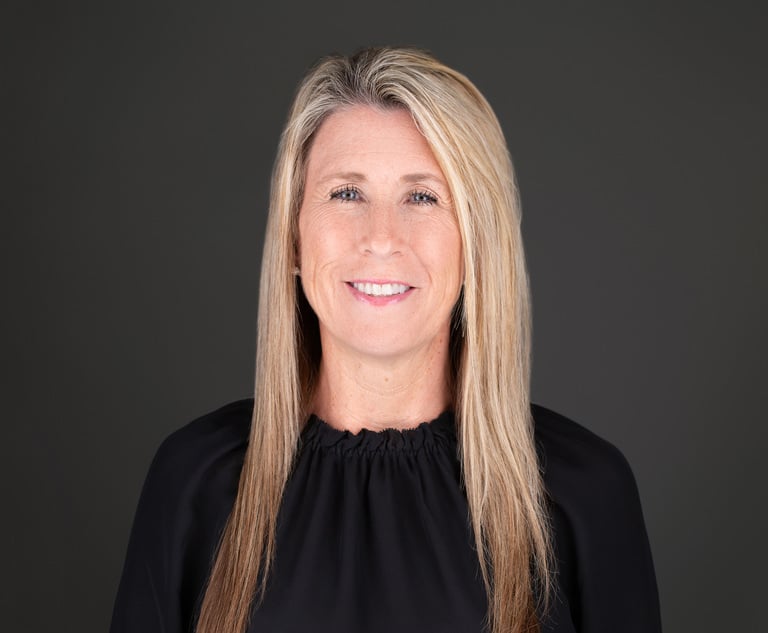Data makes the difference (Part 2)
Knowing the actual historical costs associated with settling vs. litigating, negotiating with a particular NPE or valuing a particular kind of patent allows risk managers to make informed, data-based decisions.
December 19, 2013 at 07:00 AM
7 minute read
Last month, I wrote about the central dynamic of non-practicing entity (NPE) patent suits and how this type of litigation isn't really designed to determine right or wrong or to remedy legal misconduct. The goal of NPE litigations is simply to generate a transfer of value from the alleged user of an asset to the purported owner of that asset.
In other words, NPE litigations can be viewed as more akin to financial transactions than true disputes over distinct legal issues. And the most effective way to reduce the $11 billion annual cost of those transactions is to get them out of the courtroom and transition them into the business marketplace.
We take this approach at RPX and it demonstrably reduces the risks of NPE assertion. Companies in our network have already avoided or been dismissed from more than 1,500 litigations and avoided more than $1 billion dollars of legal costs. To succeed on a steadily larger scale, this kind of approach will require more participants and, especially, more transparency.
More than 100 companies participated in a survey sponsored by the Coalition for Patent Fairness and administered by RPX. The findings (anonymized and aggregated) have provided invaluable intelligence to help companies targeted by NPEs make smarter, more cost-effective decisions about negotiating posture, settlement or license amounts, whether to acquire patents, and whether to enter (or avoid) litigation.
To understand the pertinence this kind of market data can have for in-house IP teams and risk managers, consider just two quantitative findings from the cost study:
Patent litigation makes up two-thirds of direct NPE costs. Litigation costs (including both the legal expenses and settlements) are the largest portion of the NPE burden, but the data shows that roughly a third of the total costs are not directly related to a court case. Twenty-nine percent of operating company costs are attributable to pre-litigation spending, primarily fees to outside counsel to respond to assertion letters. And an additional 5 percent is due to costs such as patent acquisition, re-exams and prior art searches. Given the proven effectiveness of such efforts, one takeaway from the data is that companies might want to spend more on acquisitions, re-exams, and prior art searches where possible and less on directly defending the litigation.
Except in cases where the total resolution exceeded $10 million, legal defense expenses were generally half or more of the costs. For “nuisance” cases costing less than $100,000 all in, the legal defense costs far outstripped the actual payment to settle the case. Since fully 95 percent of NPE suits ultimately settle, from a purely economic perspective, looking at no other factors, the data would imply that there are efficiencies—especially in less expensive cases—to reaching a settlement quickly or in advance of litigation, and limiting or avoiding legal fees.
Knowing the actual historical costs associated with settling vs. litigating, negotiating with a particular NPE or valuing a particular kind of patent allows risk managers to make informed, data-based decisions. The ability to look at patent risk as a business or market valuation rather than a legal dispute can be worth millions of dollars in avoided costs. Currently, the full findings are available only to participating companies, but top line extracts from the study can be reviewed in “RPX 2012 Cost Study – High-level Findings.”
RPX has begun publishing an NPE Activity Report that details the specific assertion behavior of known NPEs. I'll discuss this report—and how it can bring further transparency and efficiency to the patent market—in future columns.
Last month, I wrote about the central dynamic of non-practicing entity (NPE) patent suits and how this type of litigation isn't really designed to determine right or wrong or to remedy legal misconduct. The goal of NPE litigations is simply to generate a transfer of value from the alleged user of an asset to the purported owner of that asset.
In other words, NPE litigations can be viewed as more akin to financial transactions than true disputes over distinct legal issues. And the most effective way to reduce the $11 billion annual cost of those transactions is to get them out of the courtroom and transition them into the business marketplace.
We take this approach at RPX and it demonstrably reduces the risks of NPE assertion. Companies in our network have already avoided or been dismissed from more than 1,500 litigations and avoided more than $1 billion dollars of legal costs. To succeed on a steadily larger scale, this kind of approach will require more participants and, especially, more transparency.
More than 100 companies participated in a survey sponsored by the Coalition for Patent Fairness and administered by RPX. The findings (anonymized and aggregated) have provided invaluable intelligence to help companies targeted by NPEs make smarter, more cost-effective decisions about negotiating posture, settlement or license amounts, whether to acquire patents, and whether to enter (or avoid) litigation.
To understand the pertinence this kind of market data can have for in-house IP teams and risk managers, consider just two quantitative findings from the cost study:
Patent litigation makes up two-thirds of direct NPE costs. Litigation costs (including both the legal expenses and settlements) are the largest portion of the NPE burden, but the data shows that roughly a third of the total costs are not directly related to a court case. Twenty-nine percent of operating company costs are attributable to pre-litigation spending, primarily fees to outside counsel to respond to assertion letters. And an additional 5 percent is due to costs such as patent acquisition, re-exams and prior art searches. Given the proven effectiveness of such efforts, one takeaway from the data is that companies might want to spend more on acquisitions, re-exams, and prior art searches where possible and less on directly defending the litigation.
Except in cases where the total resolution exceeded $10 million, legal defense expenses were generally half or more of the costs. For “nuisance” cases costing less than $100,000 all in, the legal defense costs far outstripped the actual payment to settle the case. Since fully 95 percent of NPE suits ultimately settle, from a purely economic perspective, looking at no other factors, the data would imply that there are efficiencies—especially in less expensive cases—to reaching a settlement quickly or in advance of litigation, and limiting or avoiding legal fees.
Knowing the actual historical costs associated with settling vs. litigating, negotiating with a particular NPE or valuing a particular kind of patent allows risk managers to make informed, data-based decisions. The ability to look at patent risk as a business or market valuation rather than a legal dispute can be worth millions of dollars in avoided costs. Currently, the full findings are available only to participating companies, but top line extracts from the study can be reviewed in “RPX 2012 Cost Study – High-level Findings.”
RPX has begun publishing an NPE Activity Report that details the specific assertion behavior of known NPEs. I'll discuss this report—and how it can bring further transparency and efficiency to the patent market—in future columns.
This content has been archived. It is available through our partners, LexisNexis® and Bloomberg Law.
To view this content, please continue to their sites.
Not a Lexis Subscriber?
Subscribe Now
Not a Bloomberg Law Subscriber?
Subscribe Now
NOT FOR REPRINT
© 2025 ALM Global, LLC, All Rights Reserved. Request academic re-use from www.copyright.com. All other uses, submit a request to [email protected]. For more information visit Asset & Logo Licensing.
You Might Like
View All
Amex Latest Target as Regulators Scrutinize Whether Credit Card Issuers Deliver on Rewards Promises

Wells Fargo and Bank of America Agree to Pay Combined $60 Million to Settle SEC Probe

‘Extremely Disturbing’: AI Firms Face Class Action by ‘Taskers’ Exposed to Traumatic Content
5 minute readTrending Stories
- 1Paul Hastings, Recruiting From Davis Polk, Continues Finance Practice Build
- 2Chancery: Common Stock Worthless in 'Jacobson v. Akademos' and Transaction Was Entirely Fair
- 3'We Neither Like Nor Dislike the Fifth Circuit'
- 4Local Boutique Expands Significantly, Hiring Litigator Who Won $63M Verdict Against City of Miami Commissioner
- 5Senior Associates' Billing Rates See The Biggest Jump
Who Got The Work
J. Brugh Lower of Gibbons has entered an appearance for industrial equipment supplier Devco Corporation in a pending trademark infringement lawsuit. The suit, accusing the defendant of selling knock-off Graco products, was filed Dec. 18 in New Jersey District Court by Rivkin Radler on behalf of Graco Inc. and Graco Minnesota. The case, assigned to U.S. District Judge Zahid N. Quraishi, is 3:24-cv-11294, Graco Inc. et al v. Devco Corporation.
Who Got The Work
Rebecca Maller-Stein and Kent A. Yalowitz of Arnold & Porter Kaye Scholer have entered their appearances for Hanaco Venture Capital and its executives, Lior Prosor and David Frankel, in a pending securities lawsuit. The action, filed on Dec. 24 in New York Southern District Court by Zell, Aron & Co. on behalf of Goldeneye Advisors, accuses the defendants of negligently and fraudulently managing the plaintiff's $1 million investment. The case, assigned to U.S. District Judge Vernon S. Broderick, is 1:24-cv-09918, Goldeneye Advisors, LLC v. Hanaco Venture Capital, Ltd. et al.
Who Got The Work
Attorneys from A&O Shearman has stepped in as defense counsel for Toronto-Dominion Bank and other defendants in a pending securities class action. The suit, filed Dec. 11 in New York Southern District Court by Bleichmar Fonti & Auld, accuses the defendants of concealing the bank's 'pervasive' deficiencies in regards to its compliance with the Bank Secrecy Act and the quality of its anti-money laundering controls. The case, assigned to U.S. District Judge Arun Subramanian, is 1:24-cv-09445, Gonzalez v. The Toronto-Dominion Bank et al.
Who Got The Work
Crown Castle International, a Pennsylvania company providing shared communications infrastructure, has turned to Luke D. Wolf of Gordon Rees Scully Mansukhani to fend off a pending breach-of-contract lawsuit. The court action, filed Nov. 25 in Michigan Eastern District Court by Hooper Hathaway PC on behalf of The Town Residences LLC, accuses Crown Castle of failing to transfer approximately $30,000 in utility payments from T-Mobile in breach of a roof-top lease and assignment agreement. The case, assigned to U.S. District Judge Susan K. Declercq, is 2:24-cv-13131, The Town Residences LLC v. T-Mobile US, Inc. et al.
Who Got The Work
Wilfred P. Coronato and Daniel M. Schwartz of McCarter & English have stepped in as defense counsel to Electrolux Home Products Inc. in a pending product liability lawsuit. The court action, filed Nov. 26 in New York Eastern District Court by Poulos Lopiccolo PC and Nagel Rice LLP on behalf of David Stern, alleges that the defendant's refrigerators’ drawers and shelving repeatedly break and fall apart within months after purchase. The case, assigned to U.S. District Judge Joan M. Azrack, is 2:24-cv-08204, Stern v. Electrolux Home Products, Inc.
Featured Firms
Law Offices of Gary Martin Hays & Associates, P.C.
(470) 294-1674
Law Offices of Mark E. Salomone
(857) 444-6468
Smith & Hassler
(713) 739-1250







